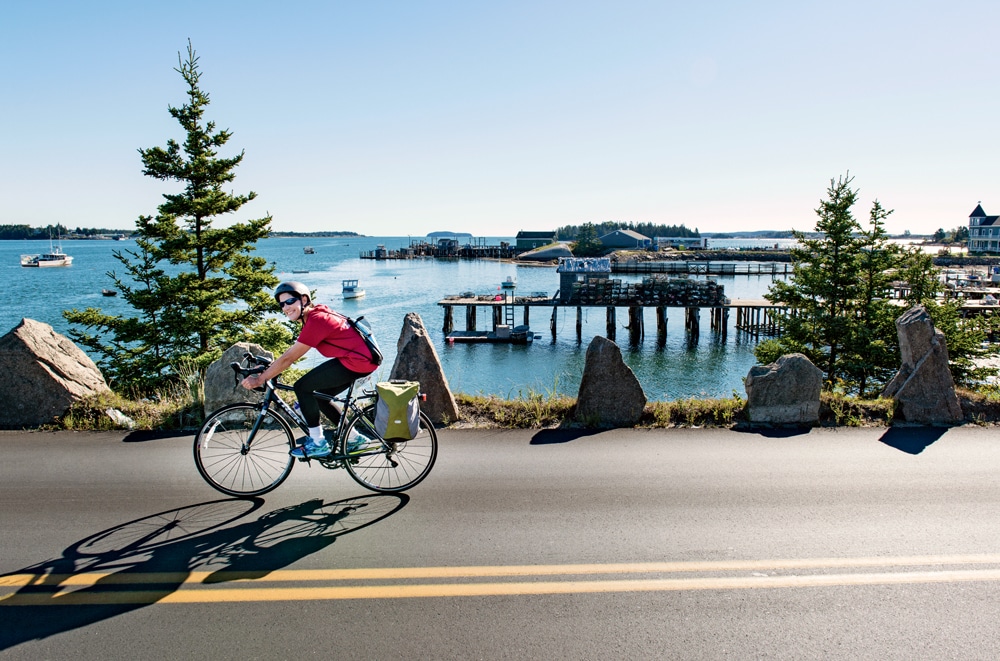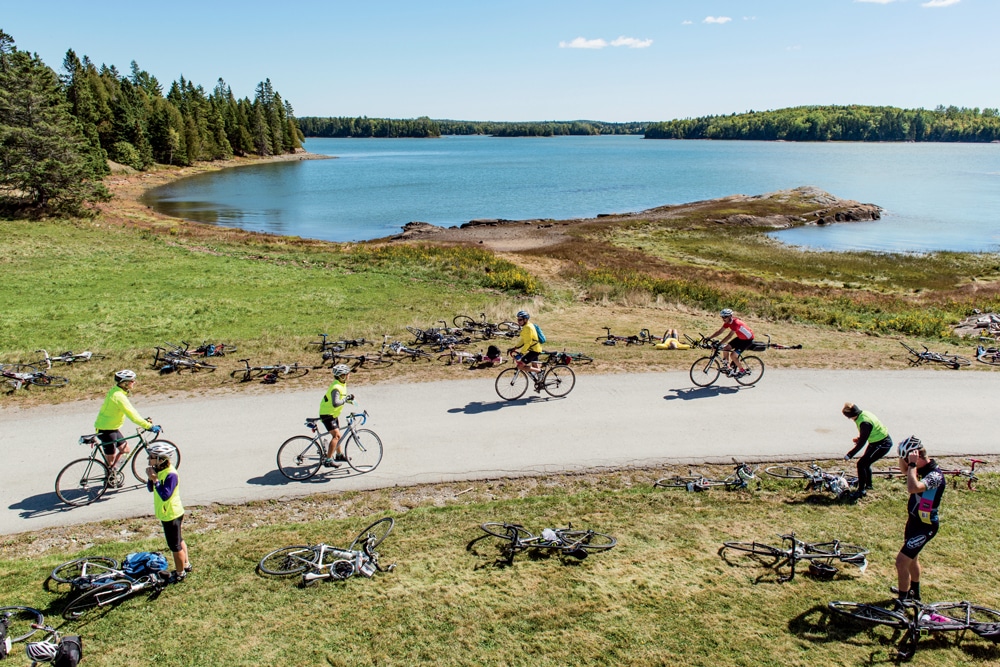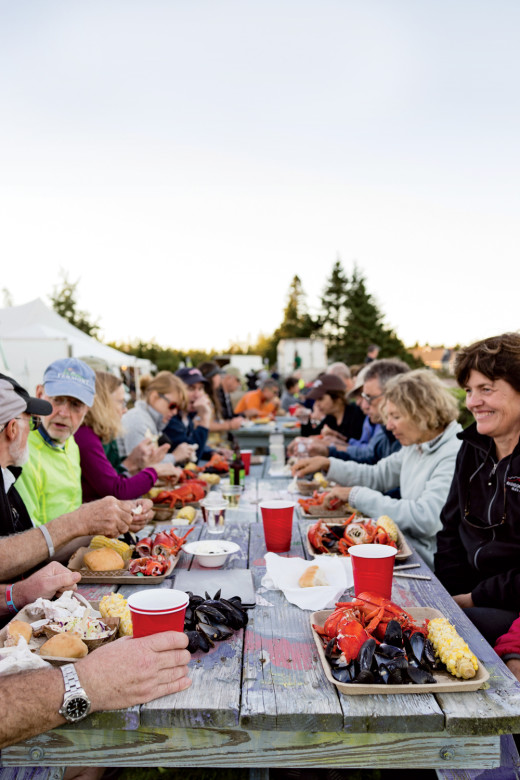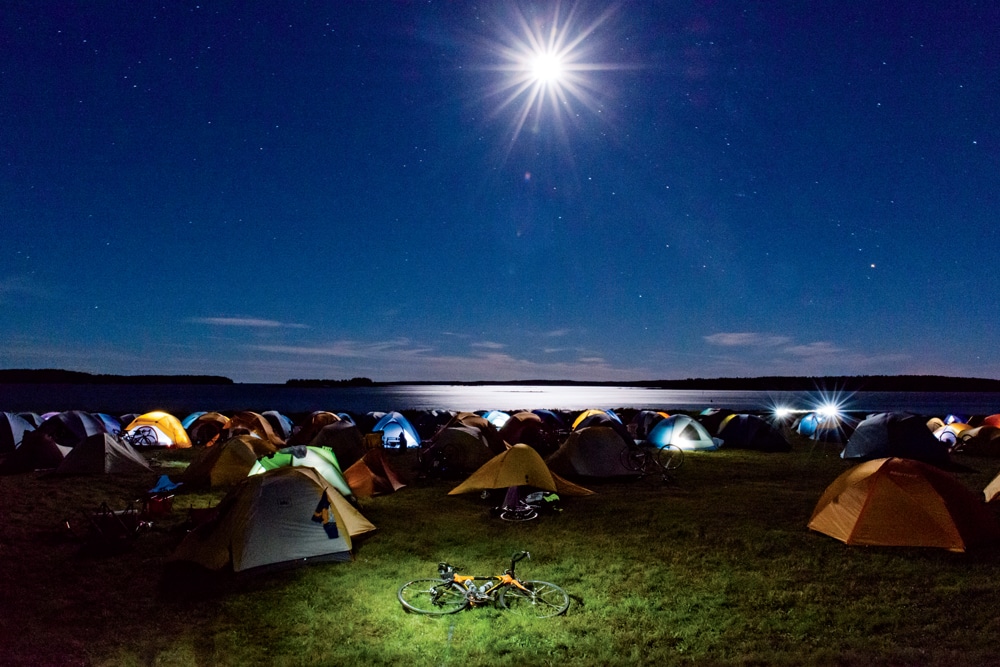Tour de Maine | First Light
An unforgettable bike trip into the heart of a famous landscape and the lives of its people.

Among the rewards for BikeMaine’s avid cyclists are ocean vistas like this one, which greeted the author during a Beals Island jaunt on day 2 of the weeklong, 354-mile tour.
Photo Credit : Heather Perry
Photo Credit : Heather Perry
Watch out! Sand!” I hear the woman I’m riding with warn me at the very moment my bike slides out from under me. Even as her words float into my ear, I’m down. Luckily, I’m more shocked than hurt, and it’s only later at our (astonishingly beautiful) oceanside campsite that evening that my brain truly registers the fall. The car behind me didn’t hit me, and the merging road immediately in front of me was empty. My bike is intact and—discounting a scraped knee—so am I.
It’s Sunday, day 1 of BikeMaine 2016, and I have started with a bang, or at any rate a splat.
The annual seven-day ride is organized by the nonprofit Bicycle Coalition of Maine as a way for participants to “explore the people, places, culture, landscape, and food of Maine.” This is the third consecutive year that my sister Carolyn and I have signed up. I’ve lived in Maine just three years, but my job as a newspaper editor requires that I know the place like an old-timer. The appeal of getting to know it at the leisurely pace of a bicycle outweighs my ever-present anxiety about my ability to ride 60-plus miles a day.
A day earlier, Carolyn and I and 398 other cyclists from across the country and around the world congregated on a sunny September afternoon on the Schoodic Peninsula, the less-traveled part of Acadia National Park. We were surrounded by iconic Maine scenery: scraggy pines, crashing waves, rock-strewn beaches. Also hundreds of bicycles, piles of gear, and many rangy, muscular 50- and 60-somethings. More than a third of us are repeat riders—which tells you something. The youngest rider, I later learn, is 26; the oldest is 79.
Each year, BikeMaine focuses on a different area of the state. In 2016 the route zigzags from the Schoodic Peninsula to Eastport and back again, covering 354 miles in one of Maine’s more remote, impoverished, and—I am about to discover—ravishing regions. Though I live in Portland, I’ve never been here before.
The Bicycle Coalition of Maine launched BikeMaine in 2013 to promote bicycle tourism as a path to local economic development. Staffers work with the communities along the route, plotting the off-the-beaten-path rides and integrating everything local: food and drink, farms, libraries, historical societies, conservation organizations. By the time we bikers arrive, these villages are as intrinsic to the experience as the cycling.
Day 1 brings a breathtaking ride, despite the scary tumble and an even scarier fast-moving storm, the only bad weather in a week of blue skies. Before I know it, I’m in Jonesport, the day’s destination. Sawyer Memorial Congregational Church—a church of the elegantly simple, white-steepled New England sort—has opened its doors to us. Carolyn and I snack on homemade molasses cookies in the church basement and check out a craft fair on the lawn. Then a member of the congregation steers us to the sanctuary, where the church organist sits at the big pipe organ previewing the Christmas service by candlelight just for us. Joy to the world indeed.
On my desk as I write this sits a miniature lobster trap, a souvenir given to each and every rider by the town of Machias, where we camp on day 2. The town manager itemizes the trap components as we polish off barbecued chicken, kale salad, green beans, baked potatoes, and hermit cookies (all meals and snacks are included in the $875 price). She explains that inmates from the Downeast Correctional Facility made the traps from Maine balsam wood, while she herself made the blue soap lobsters, which smell like blueberries, a nod to the region’s signature crop. The traps also hold dollhouse-sized scrolls that tout Machias’s attributes, summarizing the town as “unique as a rare blue lobster.”

Photo Credit : Heather Perry
BikeMaine can feel like a happy roving summer camp for grown-ups, and, as at camp, we quickly settle into a routine: There are blueberry bogs and blueberry crisps, and many (sometimes too many) short, steep hills with many (sometimes too many) Maine-made Bixby bars to fuel the climbs. There are waving schoolchildren along the road, then ringing cowbells and applause when we reach camp. The lines for hot showers, post-ride beer gardens, and communal teeth-brushing under the stars are reliably sociable. Bedtime is early—“Nine p.m. is biker midnight,” a rider tells me—and we rise early, too. Because I am slow, a passing cyclist’s “On your left” becomes the rhythm and refrain to which I ride.

Photo Credit : Heather Perry
The Down East beauty, though, is never routine. On the days when my back aches, my legs protest, my lungs huff, and I am wondering what I could have been thinking to spend my vacation like this, I remind myself to look around. Spectacular! Miraculous! Magical! Awesome! I write all these words, with all these exclamation points, in my trip diary. Our campsite on private land at Kelley Point is so beautiful that I consider staying there and abandoning the ride. The stunning route into Eastport has me contemplating a move Down East. Awesome in the true sense of the word, I scribble by flashlight in my tent after we pedal to Reversing Falls Park in Pembroke.
We snap out of our collective routine one evening in Eastport. Two riders in cycling shirts and shorts who have lived together for years casually stand up in the big communal tent where we’ve been eating a tasty salmon dinner. A rabbi materializes and, before a cheering congregation of bicyclists, they pledge their love. The most stress-free wedding ever, the bride tells me later.
On day 5, we ride through blink-and-you’ll-miss-it Dennysville, one of many villages in which the cyclists outnumber the residents. I hop off my bike to take in the Audubon exhibit at the Academy Vestry Museum, quite possibly the most charming museum in Maine. It has opened specially to accommodate us, and inside I learn that John James Audubon preceded us Down East by almost two centuries.
The next day, in even-smaller Whitneyville, a 70-something gentleman named Skip happens to hear me ask about the local library, a former schoolhouse. Skip locates the library key and gives me a private tour, spinning tales of the school it had been in his boyhood, when there was no plumbing or electricity and the reward for good behavior was getting to ring the big cast-iron school bell. The money the town has raised by feeding the cyclists will go toward renovating the building, he says.

Photo Credit : Heather Perry
BikeMaine 2016 ends with an exhilarating ride on perfectly paved park service roads into Acadia. There’s one last excellent lunch, then I’m lugging dirty gear to the car, loading up my bike, and hugging new friends good-bye. When I get home, flush toilets and cotton sheets briefly turn my place into the poshest of four-star hotels. It’s nice to wake up without worrying about rain. Still, for a week or two I struggle to make the transition from two wheels. In the car, I find myself fixated on hills and fretting over cratered road surfaces. And then, gradually, my BikeMaine adventure recedes. My days shift from sweating hills to sweating deadlines. Though I sit for hours, it’s on a swivel-tilt office chair, and the glow comes from a computer screen and not incandescent skies. Another year will pass before I am on a bicycle saddle again, riding BikeMaine, with the state unfolding and revealing itself inch by inch and mile by mile as I roll by.
For more information on the BikeMaine tour, go to ride.bikemaine.org.


